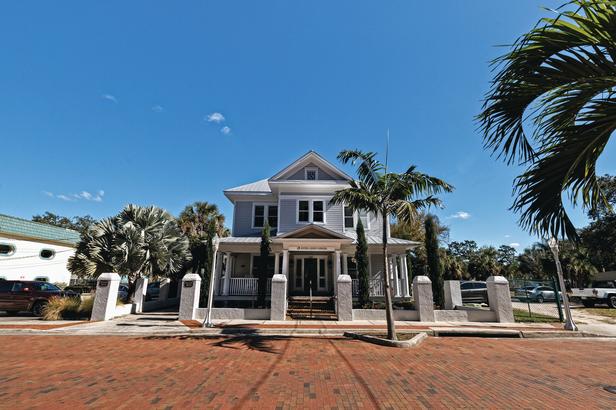Ghosts from the past do not appear to be haunting the old house at 1619 Jackson St. in downtown Fort Myers. If they’re indeed there, they appear to be enhancing it.
Built in 1909 by the Pavese family, the house has served a variety of purposes and tenants. From 1943 to 1979, a branch of the Hendry family owned it and used it as both a home and a boarding house; renters lived in the six bedrooms upstairs.
Attorneys had been using the home in more recent years for their offices. But in June 2020, a modern-day Hendry got his hands back on the house. Maxwell, Hendry & Simmons property appraisers purchased it for $285,000 and began restoring the home to its former glory. Although they wouldn’t divulge the cost of the renovations, they did admit they spent more on the renovation than they did the purchase.
They moved inside Nov. 30, 2020, following six months of work. “We wanted to be downtown, first and foremost,” says property appraiser Gerald Hendry. Previously, their offices had been off New Brittany Boulevard, just north of College Parkway in south Fort Myers. “This was a great opportunity to be walkable downtown.”
Adorned with photographs of Fort Myers from the early to mid-1900s, the house now serves as the offices of the property appraiser firm. What used to be the living room is now the foyer. What used to be the kitchen is now a storage area and another office. The six bedrooms upstairs are now offices and a kitchenette with a fridge and a microwave. The former screened-in back porch is now under air conditioning, and houses the company’s copy machine.
Gerald Hendry traced the bricks from the fireplace back to 1911 from a mill in South Carolina. And speaking of air conditioning, the house was built before A/C existed. But the ductwork had been installed in 1979 by previous owners, who just lowered parts of the ceiling, covering it with drywall, to install the ductwork.
May Hendry, Gerald’s grandma, lived on the ground floor. She owned and operated various Fort Myers restaurants, including May’s Café and Bay Café on Bay Street, which became Peter’s La Cuisine and is now Firestone Grill Bar, Martini Room and Skybar. To honor his grandmother’s memory, Gerald Hendry and his colleagues named the limited liability corporation that purchased the house “May’s Café LLC.”

“My dad, my uncle and my grandmother, they lived on the first floor,” says Hendry, who spent many a Christmas morning opening presents in what’s now a downstairs conference room.
All of the original pine-wood flooring was re-sanded, bleached and polished. The original bathtub remains in place upstairs.
“Every single surface was touched in some way,” says Matt Simmons, also a property appraiser. The Evangelical Christian School graduate connected with Jonathan Walters, a former classmate and construction contractor who has appeared on HGTV’s “Home Town” series about the continual restoration of old homes in Laurel, Mississippi. Walters jumped at the chance to restore a vintage, wood-frame house in his hometown.
“It’s one of the last houses of that age in that area of Fort Myers,” says Walters, who’s now the owner of Royal Corinthian Homes in Fort Myers. “The history and the charm and character, there’s no way to replicate that with the new constructions now. It’s always cool to restore an old building.”
When home inspectors arrived that summer of 2020, they tried to talk the property appraisers out of buying it, because it had so many issues. Walters’ opinion outweighed theirs.
“How many people locally know how to do something like this?” Simmons says. “Jonathan knew. Structurally, he knew this house was going to be fine. It would be solid as a rock.”
Most buildings that age have a bit of tilt to them. Walters went about stabilizing it. “We had a group come in, and they put support pads underneath the house,” Walters says. “Permanent braces underneath the floor system of the building. The idea was, we weren’t necessarily trying to level anything. That creates its own issues. The idea was to stabilize it and keep it from getting worse.”
In Simmons’ office, Walters left some of the original wood exposed for the effect of nostalgia. To do so, Walters took out all the pre-existing drywall behind it to adhere a black backing to protect the exposed wood and lessen the fire hazard. Then, he replaced the drywall behind and around it to create the effect of bringing back the past look on a modern wall.
“There was an old leak from the previous owner in that room,” Walters says. “Once you remove the plaster and saw how good the wood lines looked, and that charm and character it had, we were trying to figure out how to leave it. We did some things to make it safe for today’s standards.”
Some buildings can’t be saved, Walters said. But this one was worth it. “Every building is different, case-by-case,” he says. “There are times when it doesn’t make sense financially or it’s just not feasible to put the building back together again. But you try to preserve the history.”
